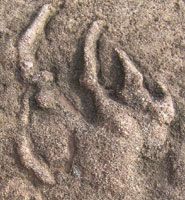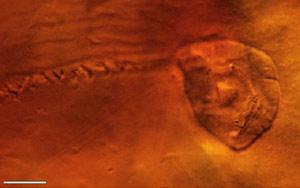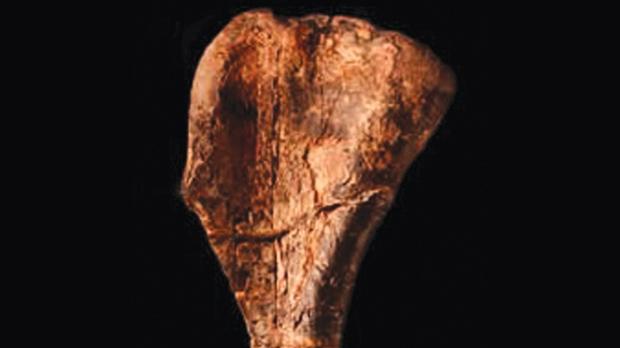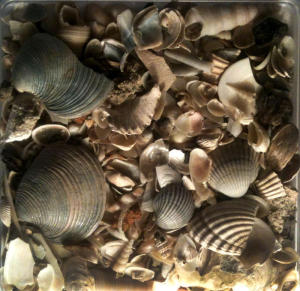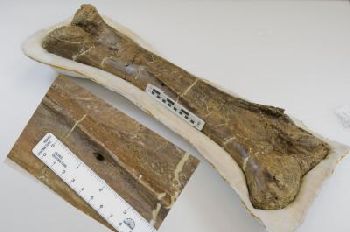A solar energy company planning a development in eastern Riverside County has discovered a rare Mojave Desert treasure-trove of Ice Age fossils, including a clutch of desert tortoise eggs believed to be the first found in California.
Paleontologists are buzzing about pieces of ivory from a mammoth tusk, the teeth of ancient horses and other indications of large vertebrate animals seldom found in California, they said. The first fossils of a sidewinder, desert horned lizard and desert kangaroo rat to be discovered in Riverside County also were located on the project site 13 miles southwest of Blythe, near the Arizona border.
“It’s quite a find,” said Casey Weaver, an engineering geologist with the California Energy Commission, which oversees licensing of the project. “It was very surprising, especially the number. We’ve never had a site that is so fossiliferous.”
The fossils were discovered as the developer, BrightSource Energy, prepared an environmental review for its application last year for the Rio Mesa solar complex. This week, the company submitted revised plans for how it will proceed with its project and extract what experts say is sure to be a valuable and informative cache of fossils underground.
Rio Mesa would have two solar plants on 4,000 acres. Each plant would have a 750-foot concrete tower surrounded by mirrors that focus the sun on a boiler to create steam and turn turbines. Together the facilities would generate about 500 megawatts of electricity, enough to serve 200,000 homes per year.
Most of the 800-plus fossils uncovered so far were fragments spread over eight miles on the Palo Verde Mesa, according to company documents submitted to the state.
“On a scientific level only, the finds are exciting in that it had been thought that the last Ice Age sediments laid down in the Blythe region were terraces of the Colorado River, but we can now say that animals and plants later remodeled the upper layers of these terrace sediments into a soil, and that hundreds of animals left their remains in that fossil soil,” said Joe Stewart, the project paleontologist from URS Corp.
The fossils were located in soil dating back about 14,000 years. Finding such treasures on the surface, where they had been subjected to the elements, means chances are good the fossils deeper down will be more intact and identifiable, said Eric Scott, curator of paleontology at the San Bernardino County Museum in Redlands, where the collection eventually will be curated.
Only a few paleontological records exist from the surrounding region, which makes this find noteworthy, he said. Scott was especially excited about the discovery of tortoise shell fragments and the pieces of eggs preserved inside a burrow.
“The tortoise shells are over the top. We have desert tortoise fossils from the Ice Age, but no shell fragments. That’s really significant. If you’re finding stuff that is that delicate and that rare and preserved in that good a condition, that supports arguments that other stuff down there will be really well preserved,” Scott said.
CLIMATE CHANGE CLUES
Pieces of large vertebrates were dragged by rodents into their burrows, including fragments of deer antlers, a pronghorn and what is believed to be a bighorn sheep, according to BrightSource documents filed with the state. Also found were fossils of rabbits, rodents, a badger and a coyote.
The discovery has given paleontologists an updated understanding of the prehistoric environment in that area. When combined with information about fossils found at Diamond Valley Lake, Joshua Tree, the La Brea Tar Pits, Arizona and Las Vegas, it may help provide some clues about climate change, Scott said.
The Pleistocene, from 40,000 to 11,000 years ago, was a time of dramatically shifting climates and temperatures, and produced abundant fossils that are often well-preserved and easy to date, experts said.
During that era, the Colorado River Valley was free of ice, and the lowlands were well-watered and vegetated from freshwater lakes and rivers, Scott said.
An area with lots of horses, mammoths, bison and camels would tell scientists of an abundance of food. Correlating that information with climate change over time can show how animals adapted and how they might change in the future, he said.
“We’ve moved past the idea of, ‘Wow, this is a mammoth, isn’t this cool.’ In order to understand how these animals were living and adapting to changing climate and conditions, you need not just a fossil, but samples of many different animals to tell you how the ecosystem worked,” Scott said.
It’s not known how deeply buried other Rio Mesa fossils might be, Scott said. Part of the site, which is owned by the Metropolitan Water District, was disturbed during World War II training exercises
FURTHER STUDY
In February, the Energy Commission asked BrightSource for additional excavation to determine where and how fossils are positioned beneath the surface, Weaver said.
BrightSource initially objected to the request because the work would cost the company time and money, according to documents. But this week, the company submitted a supplemental report laying out its plan for further study. The company will excavate 10 trenches about 10 feet deep and bore five deeper holes under supervision of a paleontologist.
Concern stems from the pedestals for the project’s mirrors. Driving the pylons into the ground will cause vibration that could damage any nearby fossils, the Energy Commission said. One of the conditions of certification will be training workers on what to do when they encounter fossils during excavation, the commission’s Weaver said.
BrightSource spokeswoman Kristen Hunter said the discovery won’t delay the project, which is expected to begin construction next year.
Paleontologist Stewart, of URS, said it is possible that the only fossils recovered will be “microvertebrates,” pieces such as lizard, snake and tortoise eggshell parts found by screening sediment.
“It is important to note these fossils found on the Rio Mesa site are not big flashy fossils that one would expect to see on display. Rather they are small fragments of skeletal elements,” he said. “We might not even see any of these fossils until we sort the concentrate with a microscope.”
The fossils are being stored temporarily at the URS lab in Pasadena. Once they are at the museum, the identities will be confirmed, samples will be numbered and labeled and they will be added to a digital database for use by other researchers, Scott said.













 December 17th, 2012
December 17th, 2012  Riffin
Riffin 

